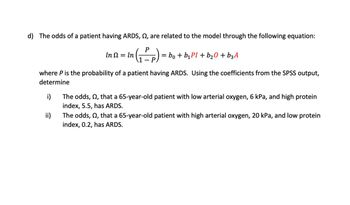
MATLAB: An Introduction with Applications
6th Edition
ISBN: 9781119256830
Author: Amos Gilat
Publisher: John Wiley & Sons Inc
expand_more
expand_more
format_list_bulleted
Question
thumb_up100%
Hi there! Is there anyone on here familiar with SPSS? would be able to help with this question?

Transcribed Image Text:Question 3
Adult respiratory distress syndrome (ARDS) is a complication in many critically ill patients. Rocker and
coworkers¹ developed a logistic regression model for predicting ARDS in a patient based on three variables:
PI Protein accumulation index.
O Arterial oxygen in kPa.
A Age in years.
Some of the output from the SPSS calculation for this model is given below.
Omnibus Testª
●
●
●
Likelihood
Ratio Chi-
Square
58.418
3
Dependent Variable: ARDS
Model: (Intercept), Protein
Accumulation Index, Arterial Oxygen /
kPa, Age / years
df
a. Compares the fitted model
against the intercept-only
model.
B
6.649
1.554
-.498
-.057
1ª
Std. Error
2.2453
.4371
Sig.
.000
.1631
.0257
Lower
Parameter
(Intercept)
Protein Accumulation
Index
Arterial Oxygen/kPa
Age / years
(Scale)
Dependent Variable: ARDS
Model: (Intercept), Protein Accumulation Index, Arterial Oxygen / kPa, Age / years
a. Fixed at the displayed value.
95% Wald Confidence Interval
2.249
.697
-.818
-.107
Parameter Estimates
Upper
Source
(Intercept)
Protein Accumulation
Index
11.050
2.411
-.179
-.006
Tests of Model Effects
Hypothesis Test
Wald Chi-
Square
8.770
12.643
Arterial Oxygen/kPa
Age / years
Dependent Variable: ARDS
Model: (Intercept), Protein Accumulation Index, Arterial Oxygen / kPa,
Age / years
9.330
4.848
df
1
1
Wald Chi-
Square
1
1
8.770
12.643
9.330
4.848
Sig.
.003
.000
Type III
.002
.028
df
Exp (B)
772.219
4.731
1
1
.608
.945
1
Sig.
1
.003
.000
.002
.028
95% Wald Confidence Interval
for Exp(B)
Lower
9.474
2.009
.441
.898
a) Comment on the overall significance of the model.
b) Comment on whether or not there is there evidence that the Protein Accumulation Index is
associated with ARDS.
Upper
62941.590
11.143
c) By considering the model coefficients, comment on how each of the three variables affects the
probability of a patient having ARDS.
.837
.994

Transcribed Image Text:d) The odds of a patient having ARDS, , are related to the model through the following equation:
(1Pp)
In Ω = ln
ii)
=
= bo + b₁PI + b₂0 + b3 A
where P is the probability of a patient having ARDS. Using the coefficients from the SPSS output,
determine
i)
The odds, n, that a 65-year-old patient with low arterial oxygen, 6 kPa, and high protein
index, 5.5, has ARDS.
The odds, 22, that a 65-year-old patient with high arterial oxygen, 20 kPa, and low protein
index, 0.2, has ARDS.
Expert Solution
This question has been solved!
Explore an expertly crafted, step-by-step solution for a thorough understanding of key concepts.
Step by stepSolved in 4 steps

Knowledge Booster
Similar questions
- Hello! Can you help with parts e,f and h? Thank you!arrow_forwardThe table below shows the hours required to produce one ton of rice or one ton of wheat in China and India. They can either devote their time to produce rice or wheat. India China 8 16 Rice Wheat What is China's opportunity cost of producing a ton of wheat? QUESTION 7 https://wtclass.wtamu.edu/webapps/assessment/take/launch.jsp?course_assessment_id=_183892_1&course_id=_55254_1&content_id=_2548933_1&step=null Rice Wheat Based on the information in this table, which of the following is true? a. China has an absolute advantage in producing rice and India has an absolute advantage in producing wheat. b. China has an absolute advantage in making both products. O c. India has an absolute advantage in making both products. d. India has an absolute advantage in producing rice and China has an absolute advantage in producing wheat. The table below shows the hours required to produce one ton of rice or one ton of wheat in China and India. They can either devote their time to produce rice or…arrow_forwardIs what I have here already correct? And how should I word the second part of the of the question?arrow_forward
- if we roll a die once find p(less than 3) or p(e even number)?arrow_forwardThis is very helpful, thank you! Could you please share the excel fomulas used to acheve this?arrow_forwardPlease answer this question; show work!! Also, make sure to look at all pictures attached to answer this question.arrow_forward
arrow_back_ios
arrow_forward_ios
Recommended textbooks for you
 MATLAB: An Introduction with ApplicationsStatisticsISBN:9781119256830Author:Amos GilatPublisher:John Wiley & Sons Inc
MATLAB: An Introduction with ApplicationsStatisticsISBN:9781119256830Author:Amos GilatPublisher:John Wiley & Sons Inc Probability and Statistics for Engineering and th...StatisticsISBN:9781305251809Author:Jay L. DevorePublisher:Cengage Learning
Probability and Statistics for Engineering and th...StatisticsISBN:9781305251809Author:Jay L. DevorePublisher:Cengage Learning Statistics for The Behavioral Sciences (MindTap C...StatisticsISBN:9781305504912Author:Frederick J Gravetter, Larry B. WallnauPublisher:Cengage Learning
Statistics for The Behavioral Sciences (MindTap C...StatisticsISBN:9781305504912Author:Frederick J Gravetter, Larry B. WallnauPublisher:Cengage Learning Elementary Statistics: Picturing the World (7th E...StatisticsISBN:9780134683416Author:Ron Larson, Betsy FarberPublisher:PEARSON
Elementary Statistics: Picturing the World (7th E...StatisticsISBN:9780134683416Author:Ron Larson, Betsy FarberPublisher:PEARSON The Basic Practice of StatisticsStatisticsISBN:9781319042578Author:David S. Moore, William I. Notz, Michael A. FlignerPublisher:W. H. Freeman
The Basic Practice of StatisticsStatisticsISBN:9781319042578Author:David S. Moore, William I. Notz, Michael A. FlignerPublisher:W. H. Freeman Introduction to the Practice of StatisticsStatisticsISBN:9781319013387Author:David S. Moore, George P. McCabe, Bruce A. CraigPublisher:W. H. Freeman
Introduction to the Practice of StatisticsStatisticsISBN:9781319013387Author:David S. Moore, George P. McCabe, Bruce A. CraigPublisher:W. H. Freeman

MATLAB: An Introduction with Applications
Statistics
ISBN:9781119256830
Author:Amos Gilat
Publisher:John Wiley & Sons Inc

Probability and Statistics for Engineering and th...
Statistics
ISBN:9781305251809
Author:Jay L. Devore
Publisher:Cengage Learning

Statistics for The Behavioral Sciences (MindTap C...
Statistics
ISBN:9781305504912
Author:Frederick J Gravetter, Larry B. Wallnau
Publisher:Cengage Learning

Elementary Statistics: Picturing the World (7th E...
Statistics
ISBN:9780134683416
Author:Ron Larson, Betsy Farber
Publisher:PEARSON

The Basic Practice of Statistics
Statistics
ISBN:9781319042578
Author:David S. Moore, William I. Notz, Michael A. Fligner
Publisher:W. H. Freeman

Introduction to the Practice of Statistics
Statistics
ISBN:9781319013387
Author:David S. Moore, George P. McCabe, Bruce A. Craig
Publisher:W. H. Freeman